
 http://www.LetsTalkArabic.com/ This title is also available at the major online book retailers. Copyright 2011 Dr. Adam Yacoub eISBN-13: 978-14-6796-874-4 All rights reserved. No part of this publication may be reproduced, stored in a retrieval system, or transmitted, in any form or by any means, electronic, mechanical, photocopying, recording, or otherwise without the written prior permission of the author. DEDICATION I wish to thank all of those who have kindly helped with introducing this book, every effort or advice have been made to trace all the covered topics but if any had been inadvertently overlooked the author will be pleased to make the necessary arrangement at first opportunity. Contents ACKNOWLEDGMENTS I'm lucky enough to have benefited from the experience of some of the experts in teaching Arabic across this edition.
http://www.LetsTalkArabic.com/ This title is also available at the major online book retailers. Copyright 2011 Dr. Adam Yacoub eISBN-13: 978-14-6796-874-4 All rights reserved. No part of this publication may be reproduced, stored in a retrieval system, or transmitted, in any form or by any means, electronic, mechanical, photocopying, recording, or otherwise without the written prior permission of the author. DEDICATION I wish to thank all of those who have kindly helped with introducing this book, every effort or advice have been made to trace all the covered topics but if any had been inadvertently overlooked the author will be pleased to make the necessary arrangement at first opportunity. Contents ACKNOWLEDGMENTS I'm lucky enough to have benefited from the experience of some of the experts in teaching Arabic across this edition.
I would like to thank everyone for his or her useful comments on this work. Part 1 Preface Congratulations mabrook Well done for making such a decision to learn the Arabic language. For whatever reason it may be, a new challenge, relocation to an Arabic speaking country or for business, you can rest assured that you have made another great decision in choosing one of the most successful and smoothest Arabic courses. This book will lead you to push yourself and take a step above the rest in a fun and interactive way. Arabic is considered one of the most alive, important and beautiful languages in the world. This book uses an extremely stimulating, logical and easy way to help you learn from the very beginning.
In any language, speaking appears to be the most fundamental aspect for a lot of people. From the start of this book, you will be introduced to the basics of speaking and pronunciation, using a simple format that allows everyone to speak Arabic in a natural way. The book will then continue to develop your new skills by enabling you to understand and heighten your ability to read, listen to and write this amazing language. Arabic is a Semitic language and is the formal and official language of 22 Arab countries. It is also the spoken language of almost 420 million people living in Arabic and non Arabic countries. This book will teach you the basics of Modern Standard Arabic (MSA), which is the modernization of the Classical Arabic structures, as well as additions from the main dialects spoken all over the Arab world.
Variations of the Language Like any other language, spoken Arabic has some dialects with variations and differences. The differences between these dialects are incomprehensible from one to the other, and can be referred to as five main dialects divided according to their regions. Maghreb The Maghreb dialect is spoken in the region of the Maghreb countries, Libya, Tunisia, Algeria, Mauritania, and Morocco. Egyptian The Egyptian dialect is used in Egypt, Sudan, Yemen, and some western parts of Saudi Arabia. It is the most widely understood colloquial dialect across the Arab world, because almost 93% of Arabic Movies, TV, and Media use the Egyptian dialect. Levantine The Levantine dialect comes from and is used in Lebanon, Palestine, Jordan and Syria.
The Gulf The Gulf dialect is spoken in the Arabic Gulf Countries, which are made up by Iraq, Kuwait, most of Saudi Arabia, Qatar, Bahrain, the United Arab Emirates, and Oman. Modern Standard Arabic MSA (Modern Standard Arabic) has become the most popular dialect and is now spoken and used by all Arab countries.  The dark countries on the map show the Arab League. Written Arabic The core of Arabic writing that is used today comes from the classical Arabic which is principally defined as the Arabic used in the Qur'an and in the earliest form of literature from the Arabian Peninsula. Two Important Facts The first point is that although every language has a vast wealth of vocabulary, we don't need to learn it all to be able to communicate. Just, 20% of the words in a language make up to 80% of the conversations we face in our daily life.
The dark countries on the map show the Arab League. Written Arabic The core of Arabic writing that is used today comes from the classical Arabic which is principally defined as the Arabic used in the Qur'an and in the earliest form of literature from the Arabian Peninsula. Two Important Facts The first point is that although every language has a vast wealth of vocabulary, we don't need to learn it all to be able to communicate. Just, 20% of the words in a language make up to 80% of the conversations we face in our daily life.
You may not be speaking like a native immediately, but you'll have a solid base and the ability to keep improving and developing yourself. This method is suitable for everyone from frequent travelers to first timers, as well as language students and enthusiasts. So, this book focuses on the vital 20% that will help you to speak Arabic interactively and dynamically. The second - really exciting point is that; Arabic language uses word roots, for example. We can take one root like ( KTB ) from the word ( K a T a B a) which means "he wrote" and from there conjugate all Arabic verbs tense.  Arabic grammar is fairly simple compared to Western languages, but the language itself has richness in its vocabulary that exceeds most languages in the Western world.
Arabic grammar is fairly simple compared to Western languages, but the language itself has richness in its vocabulary that exceeds most languages in the Western world.  Arabic grammar is fairly simple compared to Western languages, but the language itself has richness in its vocabulary that exceeds most languages in the Western world.
Arabic grammar is fairly simple compared to Western languages, but the language itself has richness in its vocabulary that exceeds most languages in the Western world.
Below are the Arabic alphabet and key to show you how to pronounce them. Try to read paying attention to the pronunciation. 
 UNIT ONE Saying "Hello"
UNIT ONE Saying "Hello" 
 UNIT ONE Saying "Hello"
UNIT ONE Saying "Hello"  Contents - - - - -
Contents - - - - -
- Hello! as-salaamu Aalaykum!  In this lesson you will learn some basic greetings and how to ask "How are you?" A dialogue: Learn as Adam meets an old high school friend, Mahmoud. They haven't seen each other for long time.
In this lesson you will learn some basic greetings and how to ask "How are you?" A dialogue: Learn as Adam meets an old high school friend, Mahmoud. They haven't seen each other for long time.  Vocabulary
Vocabulary  Other useful phrases:
Other useful phrases:  Culture Notes: The most common greeting in Arabic is the phrase " as-salaamu Aalaykum " which means literally "may peace be upon you". And the most common reply is " wa Aalaykum as-salaam ", which means literally "and upon you peace".
Culture Notes: The most common greeting in Arabic is the phrase " as-salaamu Aalaykum " which means literally "may peace be upon you". And the most common reply is " wa Aalaykum as-salaam ", which means literally "and upon you peace".
But as you see in the above phrases, to learn a language, you have to learn its culture, because literal or direct translation doesn't make sense when you speak that language. The same thing in " SabaaH el-khayr " = good morning, and the response of it, which is " Sabaah en-nuur " while " nuur " means literally " light", but this is the way how Arabs greet each others, simply means: if you greet me using good words, so I have to greet you using better words!. Also there is no specific word for greeting in the afternoon. You can use simply either " as-salaamu Aalaykum " at anytime, or " masaa' el-khayr " for the afternoon as well. Vocabulary Practice Exercise 1: Answer the following questions: 1- You walk into a classroom in an Arab country, what is the first thing that you can say? 2- What would be expected in response? 3- How do you say "Good morning"? What should the response be? . 5- How do you say "Good afternoon"? What should the response be? 6- How do you say "Good night"? What should the response be? 7- How would you say "How are you doing"? How would you answer? Exercise 2: Match each word in ( A ) with an appropriate word in ( B ) to make a phrase or sentence. 5- How do you say "Good afternoon"? What should the response be? 6- How do you say "Good night"? What should the response be? 7- How would you say "How are you doing"? How would you answer? Exercise 2: Match each word in ( A ) with an appropriate word in ( B ) to make a phrase or sentence.
Next page

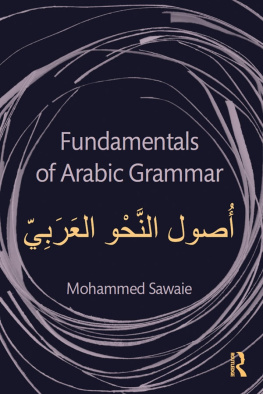

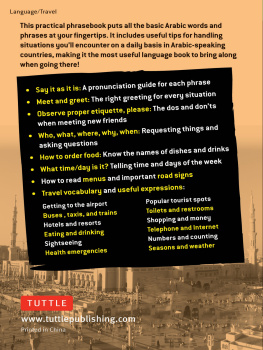


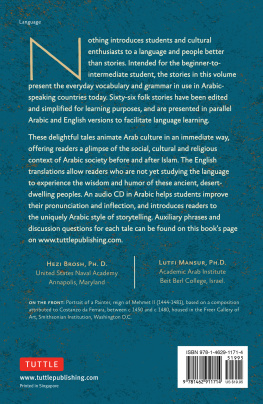
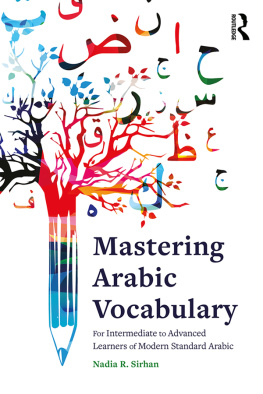

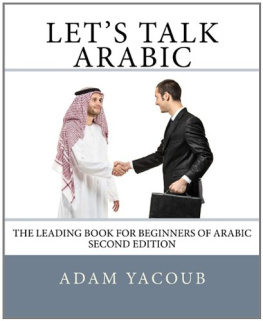

 http://www.LetsTalkArabic.com/ This title is also available at the major online book retailers. Copyright 2011 Dr. Adam Yacoub eISBN-13: 978-14-6796-874-4 All rights reserved. No part of this publication may be reproduced, stored in a retrieval system, or transmitted, in any form or by any means, electronic, mechanical, photocopying, recording, or otherwise without the written prior permission of the author. DEDICATION I wish to thank all of those who have kindly helped with introducing this book, every effort or advice have been made to trace all the covered topics but if any had been inadvertently overlooked the author will be pleased to make the necessary arrangement at first opportunity. Contents ACKNOWLEDGMENTS I'm lucky enough to have benefited from the experience of some of the experts in teaching Arabic across this edition.
http://www.LetsTalkArabic.com/ This title is also available at the major online book retailers. Copyright 2011 Dr. Adam Yacoub eISBN-13: 978-14-6796-874-4 All rights reserved. No part of this publication may be reproduced, stored in a retrieval system, or transmitted, in any form or by any means, electronic, mechanical, photocopying, recording, or otherwise without the written prior permission of the author. DEDICATION I wish to thank all of those who have kindly helped with introducing this book, every effort or advice have been made to trace all the covered topics but if any had been inadvertently overlooked the author will be pleased to make the necessary arrangement at first opportunity. Contents ACKNOWLEDGMENTS I'm lucky enough to have benefited from the experience of some of the experts in teaching Arabic across this edition. The dark countries on the map show the Arab League. Written Arabic The core of Arabic writing that is used today comes from the classical Arabic which is principally defined as the Arabic used in the Qur'an and in the earliest form of literature from the Arabian Peninsula. Two Important Facts The first point is that although every language has a vast wealth of vocabulary, we don't need to learn it all to be able to communicate. Just, 20% of the words in a language make up to 80% of the conversations we face in our daily life.
The dark countries on the map show the Arab League. Written Arabic The core of Arabic writing that is used today comes from the classical Arabic which is principally defined as the Arabic used in the Qur'an and in the earliest form of literature from the Arabian Peninsula. Two Important Facts The first point is that although every language has a vast wealth of vocabulary, we don't need to learn it all to be able to communicate. Just, 20% of the words in a language make up to 80% of the conversations we face in our daily life. Arabic grammar is fairly simple compared to Western languages, but the language itself has richness in its vocabulary that exceeds most languages in the Western world.
Arabic grammar is fairly simple compared to Western languages, but the language itself has richness in its vocabulary that exceeds most languages in the Western world. 
 UNIT ONE Saying "Hello"
UNIT ONE Saying "Hello" 
 UNIT ONE Saying "Hello"
UNIT ONE Saying "Hello"  In this lesson you will learn some basic greetings and how to ask "How are you?" A dialogue: Learn as Adam meets an old high school friend, Mahmoud. They haven't seen each other for long time.
In this lesson you will learn some basic greetings and how to ask "How are you?" A dialogue: Learn as Adam meets an old high school friend, Mahmoud. They haven't seen each other for long time.  Vocabulary
Vocabulary  Other useful phrases:
Other useful phrases:  Culture Notes: The most common greeting in Arabic is the phrase " as-salaamu Aalaykum " which means literally "may peace be upon you". And the most common reply is " wa Aalaykum as-salaam ", which means literally "and upon you peace".
Culture Notes: The most common greeting in Arabic is the phrase " as-salaamu Aalaykum " which means literally "may peace be upon you". And the most common reply is " wa Aalaykum as-salaam ", which means literally "and upon you peace".